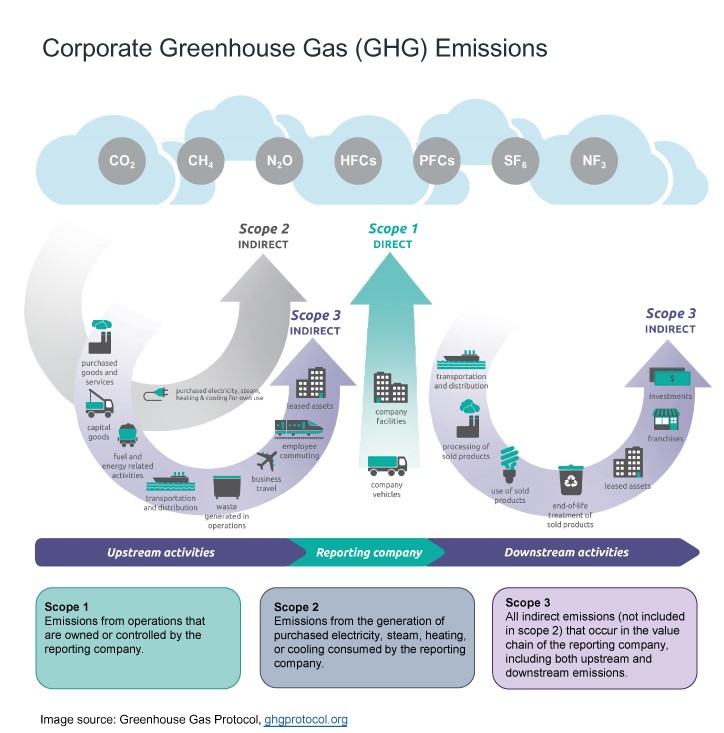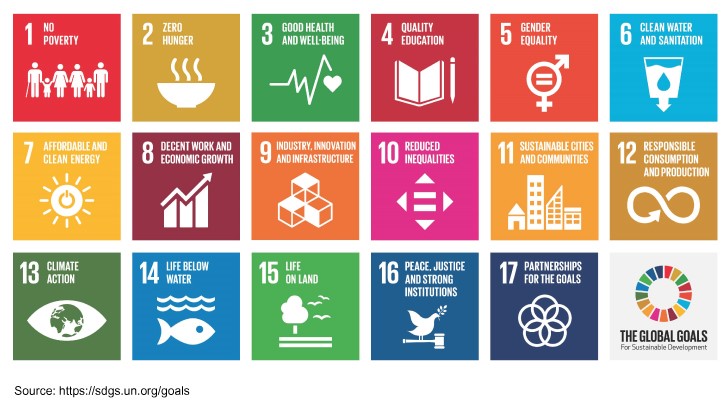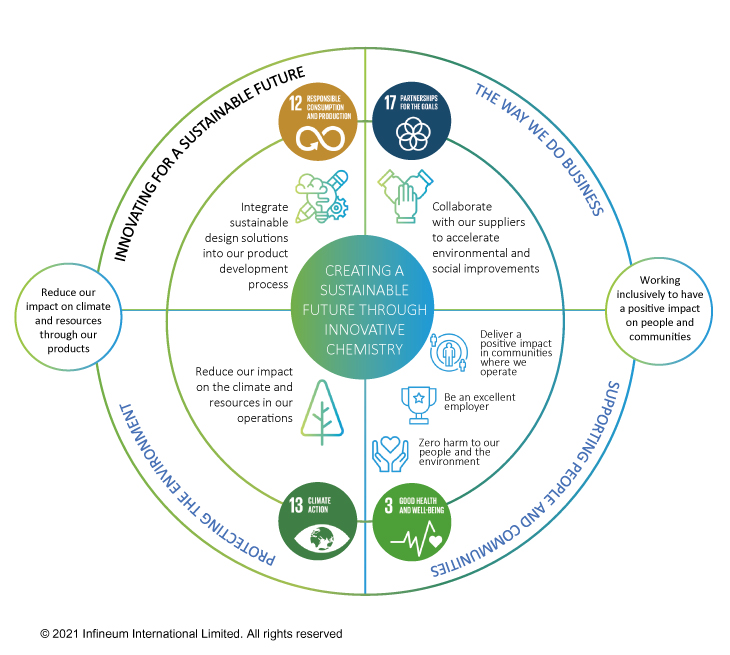Sustainability
Double e-strategy
28 August 2024
02 November 2021
Unravelling the terminology and assessing how sustainable thinking can be applied in the chemicals industry

It’s almost impossible to open an industry magazine today without finding an article on sustainability. And, as stakeholders and investors increasingly take notice and take action, there is a growing need to have a clear understanding of just what sustainability means. In this Q&A session, Maurizio Abbondanza, Infineum Sustainability and Business Growth Director, takes time to unpick some of the sustainability jargon, explore what sustainability means in the chemicals industry and to look at some of the metrics being used to help assess progress towards meeting sustainability goals.
How do you define sustainability?
The most commonly quoted definition comes from the United Nations (UN) World Commission on Environment and Development: ‘Sustainability is meeting the needs of the present without compromising the ability of future generations to meet their own needs’. In the business context, I think it is a mindset that enables businesses to focus on social, environmental and economic issues simultaneously, broadening the concept of value. It helps to make sure that the business remains profitable today, and in the future, internalising all the externalities that a traditional business approach would not consider.
How can sustainability be measured?
Sustainability is a very broad concept that involves several dimensions. The UN sustainable development goals (SDGs) are a very useful guide to channel any analysis.
For an organisation to measure its sustainability it should consider a number of indicators including economic, social and environmental criteria. Data-driven KPIs need to be set in order to measure sustainability performance, for example the amount of waste generated, employee turnover, the amount of carbon produced per tonne of product. And, to demonstrate its commitment to sustainability to both internal and external stakeholders, the organisation should report on its sustainability performance via a sustainability report.
Of rising interest in our industry is the way in which we quantify the CO2 contributions of a product to the environment from cradle to grave, and carbon footprinting or Life Cycle Assessment (LCA) methodologies can be used to do this. Carbon footprinting and LCA go beyond the traditional focus of a company’s own production sites and instead assess the impact of a product across its whole life cycle. Carbon footprinting and LCA are scientific methods, governed by international standards, that allow the evaluation of organisations, products, processes, and services.
Can you give a real example of how LCA is being used in the chemicals industry?
LCA is used to assess the overall environmental impact of a product across its life cycle. If we take the impact of climate change as an example, at Infineum, we know the carbon footprint of all our products, and also where the greenhouse gas (GHG) emissions occur. This helps us to determine where the main impacts occur in the life cycle and to assess where to take actions to reduce the footprint most effectively. It also helps us to evaluate the in-use benefits of our products, ensuring that our products provide a benefit to society.
What is the difference between a product’s carbon footprint and its LCA?
First let’s look at how they are similar. They both consider a product across its life cycle (whether that is cradle-to-gate or cradle-to-grave) and they use a similar methodology.
However, a carbon footprint focuses on one single environmental impact category - climate change – and, as such, only on GHG emissions. In contrast, an LCA considers all relevant environmental impacts, which may include, for example, acidification, ozone layer depletion, photochemical ozone creation and toxicity. Therefore, all relevant emissions and resources need to be considered for an LCA. Although much more complicated to both do and analyse, an LCA avoids – or at least raises awareness of burden shifting. What I mean by burden shifting is that one measure to reduce impacts in one area (e.g. the climate change impact of a product) could potentially mean an impact in another area increases. An LCA gives insight into these types of issues.
What is a science-based target?
GHG emissions reduction targets are defined as ‘science-based’ if they are in line with what the latest climate science deems necessary to meet the goals of the Paris Agreement. As a reminder, in 2015, the Paris Agreement on Climate Change saw 196 governments commit to prevent the worst effects of climate change by limiting average global temperature increases this century to well below 2˚C above pre-industrial levels. They also agreed to pursue efforts to limit temperature increases to no more than 1.5˚C.
Such temperature increases are reached when the GHGs in the atmosphere reach a certain level. This means that, as a global society, we can only emit a certain amount of additional GHGs until such temperatures are reached. This is sometimes referred to as our remaining carbon budget.
The Science-Based Target initiative (SBTi) was set up to mobilise the private sector to take urgent climate action. It has set criteria for the ways organisations can do their part to help limit temperature increase, namely via science-based targets. These criteria, covering corporate GHG emissions (scope 1, 2 and 3, see diagram below) must be met for a target to be science-based.

We hear of many organisations aiming for “net-zero” what does that mean?
Net-zero is a state in which anthropogenic emissions of GHG released to the atmosphere are balanced by anthropogenic removals. In practice, there had been no real definition of this until the recent release of the Net-Zero Standard by the SBTi. This means that many of the commitments made to date vary considerably. Based on the Net-Zero Standard, for a company I see three key requirements. First setting interim science-based targets that meet specific criteria (e.g. target ambition, boundary). Second, setting a net-zero target that includes deep decarbonisation of the value chain emissions paired with carbon removals that neutralise all residual emissions. Thirdly, companies are encouraged to compensate for unabated emissions by providing annual support to projects, programs, and solutions that provide quantifiable benefits to climate, people and nature.
To get to net-zero, the Net-Zero Standard specifies that GHG emissions must be reduced in line with the 1.5˚C temperature rise trajectory and any residual emissions must be balanced with GHG removals.
What is the difference between carbon neutral and net-zero?
The differences between carbon neutral and net-zero relate, for example, to what is included and the level of ambition.
In terms of what is included, a net-zero commitment, in compliance with the Net-Zero Standard, must cover scope 1, 2 and 3. In contrast, organisational carbon neutrality has a minimum requirement of covering scope 1 and 2, with scope 3 being encouraged.
And, in terms of the level of ambition, the Net-Zero Standard specifies that a company must reduce its emission aligned with a 1.5˚C mitigation pathway. In order to be carbon neutral, there is no requirement for a company to reduce its emissions on a certain trajectory.
What is a carbon neutral product?
A carbon neutral product is one where the life cycle carbon footprint is quantified (kg CO2e) and offset by supporting carbon reduction projects or by buying carbon credits, thereby achieving carbon neutrality. In some other situations bio-based raw materials can be used to make a product carbon neutral. International standards are in place for calculating the carbon footprint of products, and there is also a standard for product carbon neutrality.
Is carbon offsetting equivalent to reducing GHG output?
In simple terms, no it is not. Reducing GHG emissions has a direct impact on climate action. Carbon offsetting is simply a way to re-absorb CO2 to balance out those CO2 emissions that were created. Carbon offsetting is a way to achieve carbon neutrality on a specific scope (for example, a product line) or to neutralise the unavoidable carbon emissions to achieve a net-zero entity.
What are the UN Sustainable Development Goals?
In 2015, the UN Member States adopted the 2030 Agenda for Sustainable Development, which aims to provide a shared blueprint for peace and prosperity for people and the planet, now and into the future. At its heart are the 17 Sustainable Development Goals (SDGs), which you can see below, with 169 associated targets, which are integrated and indivisible.
In order to make the 2030 Agenda a reality, the UN says that a broad ownership of the SDGs must translate into a strong commitment by all stakeholders to implement the global goals.

How does Infineum align with the SDGs?
As an organisation, Infineum contributes in some way to all 17 of the SDGs. We have identified and focused our attention on four specific SDGs where we feel we can make the greatest impact and that are fully aligned with our strategy, which you can see below.

How is Infineum working to create a more sustainable future?
There are multiple areas where Infineum is addressing sustainability such as health and safety, product development, market solutions and services, procurement and production, colleagues and communities.
Health, Safety, Security & Environment (HSSE) - protecting the environment, our colleagues, contractors and the communities we operate in, is the highest priority for Infineum.
We use our innovative chemistry to help create more sustainable mobility, and bring our innovation capabilities to bear on the many challenges facing humanity. We create sustainable products that provide better environmental, social and economic benefits than current offerings in the market. For example, we are leaders in the development of lubricants and fuels that improve fuel efficiency (which helps to cut CO2 emissions) and that also extend the useful lifetime of vehicles including ships, trucks, cars and trains – thus reducing waste. We are leaders in e-mobility fluids, which are supporting the development of hybrid and electric vehicles, which reduce in-use emissions further. And, it does not stop there, we are continuing to work on our product portfolio to make it more sustainable as we replace old technologies with new offerings, In addition, we are developing new sustainability services that are strongly demanded by our customer base.
We source our products responsibly, manage our resources effectively and run our operations with the highest standards, minimising waste and emissions. We work with our suppliers to explore opportunities to increase the level of recycled materials being used in our industry, aiming at circular economy solutions wherever possible.
We put our colleagues at the heart of what we do and work hard on inclusion and diversity. Our five ‘CARES’ core values of Customer focus, Ambition, Respect, Ethics and Safety, provide a set of key attributes we measure ourselves against. These help us to provide the best possible working environment and to enable each of our colleagues to be the best they can be. We also care about the communities in which we operate. In support of this we have launched a volunteering policy to support the communities around our plants and laboratories and we support charitable work in different parts of the world.
Infineum published its first sustainability report in April 2021 in which we share details of how we are driving towards our purpose to create a sustainable future through innovative chemistry. We used the GRI global standards for sustainability reporting as inspiration to set out some of the progress we have made so far and to report on our environmental and social impacts and corporate governance.
We are very keen to collaborate with any stakeholder who is willing to progress the sustainability agenda of our industry, as we see collaboration as a critical enabler to solve the complex challenges that our society is facing.
Check out the Infineum Sustainability Report report here for more information.
Sign up to receive monthly updates via email